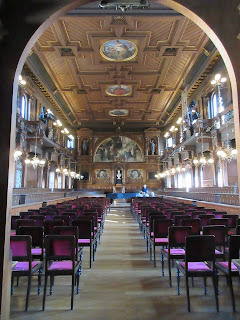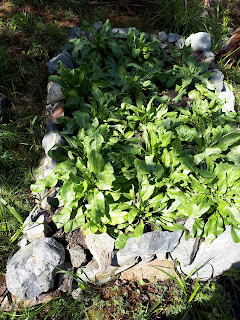Tuli suoritetua pieni piipahdus eteläiseen Saksaan! Reissu käsiti visiitit Heidelbergissä, Mainzissa ja viikonlopun Ronneburgin linnassa, ja näin reissun päätyttyä voi vain todeta että olipa kyllä hyvä matka! Aloitimme siis Heidelbergistä, jota oli kehuttu erityisen kauniiksi kaupungiksi (eikä yhtään turhaan). Kaupunki oli siis vajaan tunnin bussimatkan päässä Frankfurtin lentokentältä, ja junallakin olisi paikalle päässyt.
Hyvin varhaisesta esihistoriastahan Heidelbergistä tunnetaan heidelberginihminen, jonka ensimmäiset löydöt ovat Heidelbergin läheltä ja jota jännästi ei kyllä tuotu kaupungissa esille yhtään. Alue on ollut asuttuna kivikaudesta lähtien, ja vielä näkyviä jäänteitä on kelttiläisestä asutuksesta (n. 400 eaa) ja roomalaisesta väestöstä (löytyy temppelin jäänteitäkin, mutta siellä emme käyneet koska aika oli liian rajallinen), ja varhaisella keskiajalla alueella oli merkittäviä luostareita joiden rauniot seisovat vuorenrinteellä kaupungin vierellä edelleen. Varsinainen Heidelbergin kaupunki on perustettu jossain vaiheessa 1100-lukua. Vanhassakaupungissa on edelleen keskiaikainen katulinjaus ja torit vanhoilla paikoillaan, mutta rakennuskanta on uudempaa, pitkälti 1700-luvulta.
So, we did a quick visit to southern Germany! Our visit consisted of Heidelberg, Mainz and a weekend that was spent in Ronneburg castle, and after the trip it can only be said that it indeed was a fine trip! So, we started in Heidelberg ,which has been praised as being an exceptionally beautiful town, and I can only agree. It's about an hour's bus trip away from Frankfurt airport, and it also would've been accessible by train.
Heidelberg is famous for its very early prehistory, the first findings of the Heidelberg man are from a site near Heidelberg -but it's curious how it seems that in Heidelberg it's not remembered at all. So, the area has been inhabited since the stone age, and there are some still visible building remains put together by the Celtic people (c. 400 bce) and remains from the Roman era (there are temple remains, but we did not have time to visit them). During the early medieval times there were significant monasteries around, and their ruins still stand in a mountainside by the town. The town itself was founded during the 12th century. The old town has still the medieval street plan and squares in their old places, but the buildings are newer, mostly 18th century.
 |
| Kauppatori ja Pyhän hengen kirkko ~~~ Marketplace and the church of the Holy spirit. Kuva/photo M.Pulla |
 |
| Vanha silta (Alte Brücke, 1780-l.), tolpassa tulvahuippujen vedenkorkeuksia ~~~The old bridge, Alte Brücke (1780s). To the post water levels during floods have been marked. |
 |
| Kovin linnoitusmainen 1510 rakennettu asevarasto ~~~ Very fortress-like arsenal from the 1510s |
Heidelbergin linna
Nykyään suurilta osin raunioitunut linna on edelleen Heidelbergin maamerkki ja kohoaa edelleen komeasti vanhankaupungin yläpuolelle rinteessä. Linnasta avautuvat ehdottomasti myös kaupungin parhaat näköalat! Heidelbergin linna mainitaan jo 1200-luvun alussa, mutta nykyisen linnan paikalle rakentaminen on aloitettu 1200-1300-lukujen vaihteessa. Tästä nykyisen linnan vanhimmasta vaiheesta ei juurikaan ole jälkiä, vaan nykyisen linnan vanhin osa on 1400-luvulta ja valtaosa sitäkin nuorempaa, 1500-1600-luvuilta. Linna toimi Pfalzin vaaliruhtinaan virka-asuntona vuoteen 1720 saakka.
Linna vaurioitui 30-vuotisessa sodassa vuonna 1622 (ruotsalaiset kävivät täälläkin!), vuosisadan lopulla yhdeksänvuotisessa sodassa (1688-1697) se otti uudestaan vauriota, vielä uudelleen salamaniskusta 1764. 1800-luvulla romantiikan hengessä raunioituneesta linnasta tuli matkailukohde ja sellaisena se on siis pysynytkin. Nykyisellään yksi linnan suurimmmista nähtävyyksistä on maailman suurin viinitynnyri! Eikä edes mikään nähtävyydeksi varta vasten rakennettu, vaan tämä 1751 kasattu tynnyri vetää 220 000 litraa ja oli alkujaan ajateltu viininä maksettavien verojen keruuseen. Aikamoinen sekoitushan siitä olisi tullut...
Mielenkiintoinen kohdehan tuo linna siis on kaikkineen, mutta ehdottomasti piipahdusta harkitsevalle suosittelen audio-opastusta tai opastettua kierrosta sillä ilman linnasta ei ymmärrä juuri mitään (kylttejä on varsin vähän ja niiden tekstit valtaosin saksaksi). Hieman mutinaa aiheutti myös se, että useimpiin tiloihin ei päässyt muuten kuin opastetun kierroksen mukana eli vapaasti pyörien suurin osa sisätiloista oli lukkojen takana.
Heidelberg castle
The Heidelberg castle can still be well considered as a landmark in Heidelberg, although it's nowadays mostly in ruins. It stands in a hill towering over the old town, and from the castle there are great views to the town and surroundings! The castle is first mentioned in the early 13th century, but building a castle to its present location was started in the turn of 13th/14th century. This oldest phase of the castle has not left much traces, nowadays the oldest part of the castle is from the early 15th century, and most of the building complex is younger than that, 16th-17th century. The castle functioned as the residency of the Elector Palatine until 1720.
The castle was damaged during the 30 years war in 1622 (the Swedish were in here too!), and again during the nine years war 1688-1697. Yet again more damage was caused by a lightning strike in 1764. In the 19th century and romanticism the ruined castle became a tourist attraction and it has remained as one ever since. Nowadays one of the greatest sights in the castle is the world's largest wine barrel! And it's not one that's been built on purpose as being a tourist attraction, instead this barrel, built in 1751, was originally intended for storing the wine that had been used as a method of paying taxes. Some mixture, I can imagine...
So indeed the castle is an interesting place, but for one considering a visit I recommend getting an audioguide or a guided tour, without one it's quite hard to get a grasp of the area -there are very few information plaques and even those are in German for the largest part. Also most of the doors are locked and accessible only with a guided tour -so to say that if one roams around freely, there is not much beyond the courtyard that one can actually visit.
 |
| Linna kaupungilta katsoen ~~~ Castle seen from the town |
 |
| Näkymiä linnalta |

Heidelbergin Pyhän hengen kirkko
Komea goottilainen kirkko sijaitsi käytännössä viistosti vastapäätä majapaikkaamme, ja pitihän siellä sitten piipahtaa. Kirkko on jo kolmas tällä paikalla seisova, tämän nykyisen rakentaminen aloitettiin 1398. Kirkon komean korkuiseen torniinkin pääsi kiipeämään, kapeaa kierreportaikkoa tuntui riittävän loputtomiin! Lopulta kiipeäminen palkittiin aivan asianmukaisesti, näköalatasanteelta aukeni melkoisen messevä näkymä yli kaupungin.
The Heidelberg Church of the Holy spirit
A handsome Gothic church stood pretty much right in front of our hotel, and of course we had to peek in. This church is the third one standing in this location, the building of this one was started in 1398. One could also access the tall church tower, the narrow staircase seemed to go on forever! Once the climbing was done, however, it was totally worth all the trouble, the view across the town was nothing short of spectacular.
 |
| Yksi vettä ohjanneista räystäs-gargoileista. Jostain syystä (kirkon laajennustöistä jääneenä?) tämä ja sen muutama kaveri olivat nykyään sisätiloissa... ~~~ One of the gargoiles, surprisingly this one and a few of its friends were nowadays inside. Perhaps because of extension of the church? |
 |
| Kaupunkinäkymä kirkon tornista ~~~ City view from the tower |
 |
| Kaupunkinäkymää toiseen suuuntaan, rinteessä myös linna. ~~~ View on the other side of the tower, to the direction of the castle |
En ole aivan varma oliko kirkossa ollut aikoinaan enemmänkin maalauksia, mutta nykyisellään valtaosin valkoisessa katossa oli kuvattuna hyvinkin mielenkiintoinen musisoivien enkelien ryhmä 1400-luvulta -jokaisella erilaiset instrumentit käsissä. Lisähienona paikalla pääsi ihmettelemään (itselleni ensimmäistä kertaa ikinä!) lähietäisyydeltä hyvin yksityiskohtaista röyhelöhuntua! Kirkossa oli siis erittäin hyväkuntoinen hautamuistomerkki 1300-1400-luvun vaihteessa eläneille Saksan kuningas Ruprecht III:lle (k. 1410, kirkon rakennuttaja ja Heidelbergin yliopiston perustaja) ja vaimolleen Elizabeth von Hollenzollern'ille (k. 1411). Huntu näytti kovin siltä että siinä ei ollut erillistä leukaliinaa vaan kyseessä olisi ollut yksi yksittäinen huntukangas jossa oli röyhelö sekä kaulalla että otsalla. Hyvin mielenkiintoinen!
It was not that clear wether there had been more paintings in the church roof and walls back in the day, but nowadays it was mostly white. There was an interesting 15th century group of paintings, though, angels playing music, each one with a different musical instrument. And as for other artwork in the church, what was especially fine was that I got to examine up close a very detailed frilled veil! In the church there was an effigy of the king of Germany Ruprecht III (died 1410, the founder of both this church and Heidelberg university) and his wife Elizabeth von Hollenzollern (died 1411). The effigy was in super good condition and the veil details were clearly visible, and it seemed as instead of separate veil and wimple, Elizabeth's veil is one single piece of fabric with frills both around the face and on the neck. Very interesting!



Tämä kirkko on aikoinaan ollut myös myöhäisen keskiajan ja uuden ajan
alun Euroopan suurimman kirjaston sijaintipaikka. Bibliotheca Palatina
sai alkunsa 1386 Heidelbergin yliopiston perustamisen yhteydessä ja
1500-1600-luvuilla sitä kehuttiin "kaikkien kirjastojen äidiksi".
30-vuotisen sodan aikana se raahattiin sotasaaliina Alppien yli
kaikkineen 196 kuljetuslaatikossa, pääosin Vatikaaniin. Sittemmin osa
teoksista, saksankieliset, on palautettu Heidelbergiin.
This church was originally the place where the largest library in late medieval and early modern Europe was located. Biblotheca Palatina had its start when the Heidelberg university was founded in 1386, and in the 16th-17th century it was praised as being the "mother of all libraries". During the 30 year war, however, the library was transported over the Alps to Rome as a war booty -it took 196 boxes to carry it. Later some of the contents of the library have been returned, namely the ones written in German.
Yliopiston museo
Yliopistostahan tässä oli muutenkin jo puhetta, ja vielä aamulla ennen kun lähdettiin kohti Mainzia piti piipahtaa yliopiston omassa museossa. Aika aikaisessa vaiheessa selvisi jo, että Heidelbergin yliopiston kirjaston kokoelmiin kuuluva 1300-luvun alun upeasti kuvitettu Codex Manesse ei ole nähtävillä julkisesti, kirjastossa olisi nähtävänä tosin näköispainos, mutta kyllähän museossa nähtävää oli silti. Vierailu hiukan kärsi tosin siitä, että oikein mukavan henkilökunnan kovasta yrityksestä huolimatta audioguidea ei saatu toimimaan joten olimme (hiukan puutteellisella kielitaidolla) saksankielisten tekstien varassa, mutta vallan kiva pieni museo silti. Museo käsitteli opiskelijaelämää aikojen saatossa, yliopiston tutkimusta ja oppilaitokseen liitoksissa olleita henkilöitä, mutta kovin paljoa enempää en kylteistä oikein ymmärtänyt.
University museum
As the university had already been mentioned, in the morning before we headed off to Mainz we decided to peek in the University museum. It was already clear that the star of the Heidelberg university collections, wonderfully illustrated early 14th century Codex Manesse is not on display (there would've been a facsimile in the library, though), but there was indeed a lot to see in the museum anyway. Our visit suffered some from a device malfunction, friendly staff indeed tried their best but the audioguides did not work -so again we were on our own with our limited German skills. But a nice museum indeed, and if one is more fluent in German, I suspect the visit is even nicer. There was a lot of text concerning the student life in Heidelberg throughout history, research made in there and people that had been involved with the university, but that was pretty much all I could figure out.
 |
| "Vanha sali" ~~~ Alte Aula, The Great hall |
 |
| 1400-luvun puolivälin Baijerin ruhtinaan kronikan näköispainos (cod. pal. Germ. 96) ~~~ Mid-15th cent. Chronicle of the Prince of Bayer (Cod. Pal. Germ. 96), a facsimile |
 |
| Vaaliruhtinas Ottheinrich von der Pfalz (1556-1559, kopio maalauksesta). Äärettömän komeat vaatteet! ~~~ Prince-elector Ottheinrich von der Pfalz (1556-1559, copy of the original painting). Such handsome clothes! |
 |
| Olipa Manesse huomioitu sentään, kirkossa oli myynnissä hyvä setti postikortteja! ~~~ Codex Manesse, although not on public display, was featured in postcards! |
History of the Bibliotheca Palatina

















